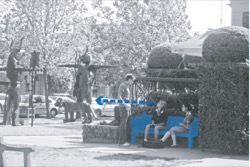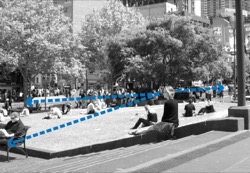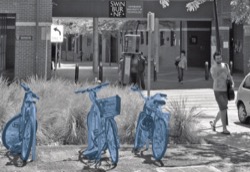On this page:
What is street and park furniture?
Street and park furniture includes:
- seats
- waste bins
- drinking fountains
- café furniture
- bicycle parking hoops
- post boxes
- parking meters
- payphone cabinets
- vending and ticket machines.
This element also includes public art, play and active recreation equipment.
Street and park furniture and public art support the function and vitality of public places. Equally important is their contribution to the enjoyment of being in public spaces.
The presence of seats and other amenities invites people to gather and linger in a place. Public spaces are also safer and more attractive when people are present. Seats and other amenities should be located where as many people as possible will want and be able to use them.
6.2.1: locate street and park furniture in accessible and convenient places
Seating is the most frequently used type of furniture, followed by waste bins and bicycle hoops.
- Locate seats at public transport stops, in parks and plazas, and along pedestrian routes.
- Place seats where people gather and linger, and at locations where people can enjoy views or watch activities.
Tip: provide comfortable seating where people are expected to sit for more than 15 minutes.
- Place seats on main pedestrian routes at 100 m intervals or more frequently.
- Locate waste bins adjacent to litter generators such as food vendors, cafes or picnic areas.
Tip: waste bins may be co–located with other utilities infrastructure, such as poles, to minimise clutter.
- Locate drinking fountains adjacent to and visible from frequently used pedestrian and bicycle routes.
- Position play equipment where children would naturally play.
Tip: children will not feel safe using play equipment located in isolated places.
- Position post boxes near a safe road crossing.
Tip: boxes are used by people of all abilities and need to be safely accessible from the neighbourhood they serve.
- Position bicycle parking hoops to accommodate a bicycle on either side.
Tip: bicycle hoops can also double as tree protectors.
6.2.2: ensure that seating is attractive and comfortable
- Locate seats in a sheltered position with access to summer shade and winter sun.
Tip: by combining seating with a tree guard, you can minimise clutter and provide shade.
- Orient seats with backs against a wall or fence, facing forwards, with an interesting outlook to activity or views.

- Arrange seating with clear views of activities and entries.

Tip: places where people sit and relax need good sightlines of the whole space and its entry points. - Locate seats with no back in busy open areas where people can sit on either side.

6.2.3: ensure that the location of street and park furniture supports safety and amenity
- Place waste bins a minimum distance of 2m from public seating or play areas.
Tip: odours from bins may deter people from using seats or play equipment.
- Place post boxes, payphone cabinets, parking meters, vending and ticket machines to be accessible from, but not obstructing, the pedestrian path.
- Locate bicycle parking hoops near to an active street or use.

Tip: proximity to active uses provides informal surveillance opportunities.
6.2.4: provide for engaging, accessible active recreation and play equipment
- Select play equipment that stimulates imagination and active play.
- Provide a variety of active recreation and play equipment suitable to a range of ages and abilities.
Tip: both young and older children need to engage in stimulating imaginative play. Adults may also enjoy play and recreation equipment.
Page last updated: 09/06/23